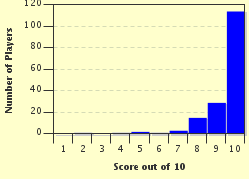Quiz Answer Key and Fun Facts
1. If you want to sing or play a tune, what is the word that describes how high or low the notes are that make up your tune?
2. Which letters of the alphabet are used to describe the white notes on a piano?
3. Which two words do we use to describe the black notes on a piano?
4. What is the name of the five lines that musical notes are written on?
5. What is the name of the squiggly sign that is shown on the left hand side of each line of musical notes to show whether the notes are going to be mainly higher or lower?
6. You are singing the song "Happy Birthday", but your friend is singing it using higher notes. What are these higher or lower levels of notes called?
7. The song "Happy Birthday" is in a major key which gives it a happy sound. What is the word used for a key which has a sadder sound, such as in a song like "Greensleeves"?
8. What is is called when you play three or four different musical notes all at the same time?
9. If you play different notes, one after another, going up higher, or going down lower, like climbing up or down a ladder, what are these notes called?
10. Supposing you hear a nice tune, and you want to play it from memory without reading it. What do you call this way of playing it?
Source: Author
Kenners158
This quiz was reviewed by FunTrivia editor
NatalieW before going online.
Any errors found in FunTrivia content are routinely corrected through our feedback system.


